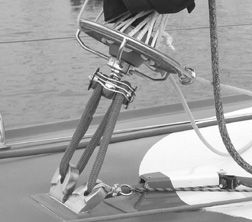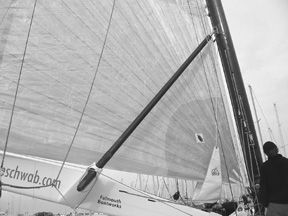
Veteran sailmaker and ocean racer Brian Hancock traveled to Les Sables d’Olonne, France for the start of the fifth edition of this demanding race-around the world, singlehanded, non-stop-and filed the following report.
The Vende Globe serves as a true test bed for on-board systems and gear because success here depends largely upon reliability. Chances are, the argonauts in this race will spend over 100, hard-charging days at sea, throughout which they must not only pilot their vessels, but maintain the gear that supports them as well.
Enormous energy and resources are spent preparing these vessels and their skippers. From that effort, equipment and systems evolve that not only withstand the extreme tests of 27,000 miles, but also exemplify desirable qualities that appeal to all boat owners-simplicity, light weight, and superior performance. Have a look:
Canting Keels and Daggerboards
All the entries in the Vende Globe carry can’ting keels, a testament to the reliability these devices have achieved as well as the performance gain they afford. These keels are moved from side to side either hydraulically or mechanically with a block and tackle system. With efficient daggerboards, and push-button can’ting mechanisms, it’s conceivable that these keel systems could be put to good use on less race-oriented craft. Because all these boats have can’ting keels, the need for daggerboards is greater than ever. There is very little directional stability in the hull shapes of these ocean-going boats, and once the keels are can’ted, the only thing that stops the boat from sliding sideways are the daggerboards. These appendages are now twice as big as they were in the past, and aboard Boundelle heavily raked aft. Asymmetrical boards work better, but most Vende Globe boats have symmetrical boards so that they can be interchanged in the event that one or the other breaks. The combination of simple can’ting keels and easy-to-operate boards could offer a huge performance boost to almost any style of sailboat without much effort.
Rudders
Aft-hung, kick-up rudders have been much refined since they were first introduced in this arena aboard PRB-the 2000 Vende Globe winner-four years ago. A simple block and tackle system is used to raise and lower the appendages, allowing the sailor the option of having just a single rudder in the water at one time. This reduces drag by a significant amount, and equally important, it removes the weather rudder from the water where it is vulnerable to hitting an object and breaking off (something that has occurred numerous times in this and other singlehanded events).
Furling Units
Roller-furling devices comprise one area where solo sailors have done much of the pioneering and the trickle down from their developmental work has truly begun to benefit the rest of the sailing public. The latest generation of furlers will likely have the same trickle down effect. In order to keep the units as light and as simple as possible, the new furlers no longer have extrusions that fit over the headstay. Rather, the furling unit itself is the headstay. Harken, Profurl, Facnor and a new company, Karver Systems from France, all make these new products. (Karver was started by some of the top people who split off from Facnor.) The drums are driven by a continuous line and the sail is attached to a torque-resistant integral headstay made from a low-stretch line like Vectran.

To get sufficient tension on the headstay, a 2:1 block and tackle system is led from a toggle under the drum aft to a winch near the cockpit and left in a jammer on deck, or tensioned by a hydraulic cylinder. The benefit of this system is that it’s light, the sail rolls up very easily, and if you have more than one unit installed, you can drop the other(s) to the deck to save weight and windage aloft. A drawback, however, is that these are furling systems, not reefing systems, so the sail has to be all the way in or all the way out. But a sail that is reefed on a conventional furler has a less than ideal shape. With these new furling systems you can have two or three of them installed and choose the sail size and shape that best suits the conditions, which of course adds expense.
Rig Innovations
The Vendee Globe fleet is rife with innovative rig ideas. The rig designers’ goal is simple: to reduce weight and windage. Removing weight from the mast means that weight can be removed from the keel while still maintaining the same stability, but achieving an overall lighter boat. For the average sailor who isn’t concerned about saving weight, its still important to minimize weight in the rig. A heavy mast adds to the heeling and pitching moment of a boat, creating motion that stresses its components and fatigues the crew.
One approach to lightening rigs is seen in the use of deck spreaders, which were invented on open-class sailboats and have been used on these vessels for almost a decade. The idea is that by widening the shroud base, the angle at which the stays intersect with the mast is much more efficient. Thus, there is not as much load on the stay to gain the required support. Less load means less compression on the mast tube and less spar weight, which equates to an overall improvement in performance. An added benefit of deck spreaders is that they provide a perfect place to sheet gennakers-in effect you are widening the boat.
While many sailors view deck spreaders as unsightly and inconvenient when in port, the plusses gained by having them soon endear them to most of the sailors who have used them. To continue this theme of innovation, Alex Thompson’s Open 60 Hugo Boss, has tiny cameras mounted at the ends of the deck spreaders so that the boat can be filmed from unique angles.
Five of the Vende Globe boats are fitted with wing masts, and one of them, aboard the lone American entry Ocean Planet, is free-standing. Opting for a wing mast means establishing a balance between weight and windage. Free-standing wing masts are heavy compared to their stayed brethren. The tube alone has to support the mast loads, whereas if you add deck spreaders and conventional spreaders, you can support a lighter tube, but you start to add windage. The nice thing about the free-standing mast is that there is nothing for the sails to chafe on and the attendant rigging doesn’t limit the size or geometry of the your sails.
Of the Vende boats that have masts with spreaders, few have conventional spreaders. Instead, there are a number of innovative ways that spreaders are used to support the masts. As with wingmasts, it’s a balance between weight and windage. The rig aboard Briton Mike Golding’s Ecover is the most innovative. This mast tube is supported by two sets of diamond stays while there are masthead shrouds with a set of hinged spreaders that hold the mast up. This allows the shrouds and the spreaders to remain fixed, while the mast and diamonds rotate. The benefit is that you gain the performance of a rotating mast while still being able to keep a very small, light, and structurally strong tube. It may take a while, but innovations in mast design like these will undoubtedly find their way into more mainstream sailboats due to their practicality.
Headboards
Simple attention to detail adds performance to any sail plan. Most of the boats have unique headboard arrangements where the actual top of the sail extends above the headboard. In some cases there is an integral block built into the headboard to allow for a 2:1 or 3:1 halyard, which is almost universal on these boats.

Reverse Vang
The gooseneck on most Open Class boats is situated either right at deck level or in some cases mounted on the deck itself-rarely on the mast. Mounting on the deck means that the mast doesn’t have to sustain the compression caused by the boom. The drawback is that there is no room for a conventional boom vang, and with mainsails that derive much of their power from massive roaches, not being able to control the back end of the sail presents a problem. The hydraulic reverse vang on Ocean Planet solves that problem, but it does require the mast to be reinforced to take the load. On PRB, the mainsail traveler extends not only all the way across the aft end of the boat, but along the side rail as well. This way the mainsheet can also be used to control the amount of tension on the leech of the sail.
Mainsheet Systems
On PRB, the mainsheet system is reversed so that the sheet itself runs inside the boom, out the front end, through a series of sheaves, and back aft. It was designed this way because of the large mainsail track. A conventional mainsheet system would likely hang up on the lifelines. While this is a somewhat convoluted approach, it largely eliminates the sheet and potential problems with it hanging up on things while jibing.
Bow Sprits
The bow sprit is another item that is used in similar fashion on many cruising boats, but which has been refined in this arena. Various arrangements are used, with two essential categories-fixed and articulating. Among the Vende entries, the consensus is that fixed sprits are best (only one of the 20 entries has an articulating sprit). These sprits are subject to enormous loads from the powerful gennakers that are attached to them.




































